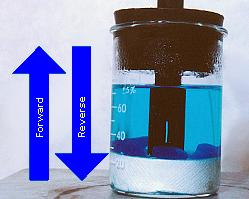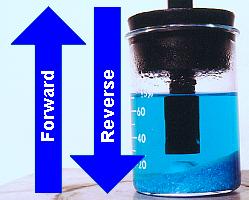A saturated solution is an equilibrium. This experiment shows the effect that surface area of the solute has on:
A constant mass of 10.0 g of copper(II)sulfate pentahydrate was dissolved in 60 mL of a
solvent made of 50% v/v isopropanol-water (this solvent mixture was used since it limited
the solubility of the CuSO4 to a conductivity value that could be measured
using a Vernier
conductivity probe). The CuSO4 was either left as large crystals of
approximately 1 - 1.5 cm in diameter, or ground to a fine powder with a mortar and
pestle. The Vernier conductivity probe was calibrated for each trial using a
standardized NaCl solution with a conductivity of 2000 ![]() S/cm. The solute was then added
to the solvent system, and stirred continuously using a magnetic stirrer. The system
with large crystals was supported on a plastic grid to prevent abrasion of the crystals
while being stirred. Data was recorded at 5 minute intervals for 7 hours.
S/cm. The solute was then added
to the solvent system, and stirred continuously using a magnetic stirrer. The system
with large crystals was supported on a plastic grid to prevent abrasion of the crystals
while being stirred. Data was recorded at 5 minute intervals for 7 hours.
|
The solution containing small crystals dissolved more quickly, as evidenced by the rapid rise in conductivity during the first few time intervals. However, the final conductivity reached was identical, within experimental error, whether the crystals were finely ground, or left in a large state.
Size of the crystals has a direct effect on the surface area in contact between solute and solvent. As the mass of solute used was the same, the finely ground crystals had a surface area many times greater than that of the large crystals. Since the solute can only dissolve from its surfaces, the initial rate of solution is much higher for small crystals. However, as the solute dissolves, the rate of crystallization also increases. Since crystallization also can also only occur at a surface, its rate is higher when the surface area is large. Therefore, the end result is the same whether the crystals are large or small, and the solubility at equilibrium is independent of surface area.
The approach to equilibrium is quicker with a larger surface area, but the position of final equilibrium is not affected.
 Apparatus used for measuring the rate of solution for a small surface area. Both forward and reverse rates are equal, but small. |
 Apparatus used for measuring the rate of solution for a large surface area. Both forward and reverse rates are equal, and large. |